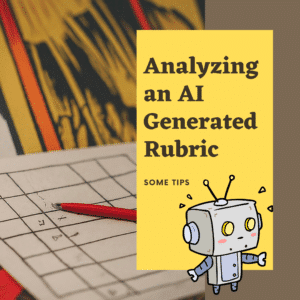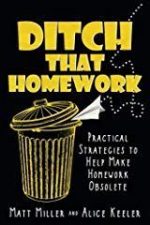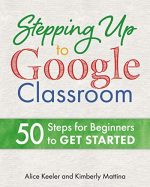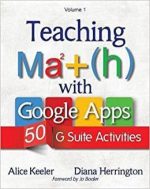In the age of AI, even rubrics are getting a high-tech makeover. But with this new tool comes the question: are AI-generated rubrics all they’re cracked up to be? While AI can be a helpful starting point, teachers need a critical eye to ensure these rubrics truly support effective assessment. What makes a good rubric? Because a rubric is more than just a checklist with points!
Register Free
Join Alice Keeler Thursday March 21st for a free workshop.
AI Created Rubrics
Previously I posted “Your AI Rubric Stinks.” I took a hard look at the real deal with AI-generated rubrics. Turns out, while AI can speed things up, it’s not quite hitting the mark on making quality rubrics that truly understand what our students need. That chat was all about why we can’t just take these AI rubrics at face value and expect them to work magic without us putting in some teacher know-how. It’s a heads-up for us to remember: AI tools are cool, but they need our input to make them really useful for teaching. Because at the end of the day, it’s about making sure these tools are helping us teach better, not just making our jobs easier.
Register Free
Join Alice Keeler Thursday March 21st for a free workshop.
What Makes a Quality Rubric?
Once again I am providing a workshop for OTIS, this time to examine what makes a quality rubric. Log in at otis.teq.com. Navigate to the Course Calendar to find the free workshops, which are color coded yellow. If you have any issues registering please contact otis@teq.com they have people on standby to help you get into the workshop. Can’t attend live? Register to gain access to the recording afterwards.
Analyzing AI Created Rubrics for Quality
In the bustling world of education, where time is a treasure often buried under heaps of responsibilities, AI-generated rubrics shine as a beacon of hope. They promise to lift the heavy load of crafting detailed assessment tools, allowing educators to navigate the more dynamic aspects of teaching. But amidst this convenience, a critical question arises: How do we ensure that these AI-crafted guides are not just quick but also quality?
The Allure of AI for Rubric Creation
The appeal of using AI for rubric creation is clear. Designing a rubric from scratch is a meticulous task that demands deep thought about content, criteria, and performance levels. It’s about aligning instructional goals with assessment strategies, a process both time-consuming and complex. Enter AI, with its ability to process vast amounts of data and generate structured tools, including rubrics. This technology promises to streamline the process, but it also introduces a challenge: ensuring the quality and effectiveness of what is produced.
Beyond the Basics: Analyzing AI-Created Rubrics
While you are probably familiar with rubric basics—clarity, specificity, and alignment with learning objectives—the real devil is in the details. Analyzing an AI-generated rubric requires a deeper dive to ensure it doesn’t just tick the boxes but truly reflects what happens in your classroom and facilitates meaningful feedback.
Integration with Instructional Goals
The first step is to ensure the rubric’s criteria mirror the specific instructional goals of your lesson or unit. If your instruction focused on critical thinking and problem-solving, the rubric should explicitly assess these skills. This alignment ensures that the rubric is not just an assessment tool but an extension of your teaching, reflecting the priorities and objectives you’ve set for your students.
The rubric should mirror the priorities established during unit planning. If your unit emphasizes analytical skills, creative thinking, or collaboration, these elements should be prominently featured and clearly defined within the rubric. This direct alignment ensures that students are aware of the expectations and understand the value placed on different aspects of their learning journey.
Adaptable to Learner Diversity
Given the variety of learners in any classroom, a rubric crafted with flexibility in mind allows for diverse expressions of understanding. While planning your unit, consider the different ways students might engage with the material and reflect this diversity in the rubric’s structure and criteria. This foresight encourages inclusivity and recognizes the varied ways students can achieve and demonstrate mastery.
Feedback-Oriented Criteria
A quality rubric has criteria that focuses on improvement
- Strengths and Weaknesses: Rather than just identifying what a student does well or poorly, feedback-oriented criteria highlight both what’s working and where there’s room for growth.
- Specific Guidance: Instead of vague statements like “Needs Improvement,” these criteria pinpoint precise areas for attention (e.g., “Develop a stronger thesis statement” or “Include more relevant evidence”).
- Actionable Language: Feedback-oriented criteria suggest concrete steps for improvement, providing students a roadmap to better performance.
NOT Feedback Oriented
Criteria: Grammar and Spelling
⭐️⭐️⭐️⭐️: No mistakes.
⭐️⭐️⭐️: Few mistakes.
⭐️⭐️: Many mistakes.
⭐️: Unreadable due to mistakes.
Feedback- Oriented
“Uses correct punctuation, demonstrating strong command of sentence structure and grammatical conventions. Areas for improvement may include varying sentence length for stylistic effect.”
Common Misconceptions
- A Simple Checklist: Rubrics go beyond ticking boxes. They offer descriptive feedback aligned with learning goals.
- Just About Points: While points can be helpful, the essence of a rubric lies in its detailed qualitative descriptions.
- Set in Stone: Rubrics can evolve. Involving students in rubric creation and adjusting them based on feedback fosters improvement.
AI Enters the Picture: Promises and Pitfalls
AI-powered rubric generators promise to save time. While these tools can provide a starting point, overreliance carries risks:
- Generic Criteria: AI-generated rubrics may offer vague criteria that don’t align precisely with your learning objectives.
- Flawed Descriptors: AI might produce descriptions that lack specificity or fail to differentiate between performance levels.
- The Illusion of Accuracy: AI-generated rubrics might still require significant editing and refinement to ensure their appropriateness.
Mathematical Flaws
In asking an AI tool for a rubric example it came back with
“Exceeds Expectations” – 4 points
“Meets Expectations” – 3 points
“Approaches Expectations” – 2 points
“Needs Improvement” – 1 point
Mathematically, this scale is horrifying.
The Problem with One-Point Differences in Rubrics
The expectations of an assignment are what we are telling students we expect in order for them to receive full credit. Mathematically, consider what “Approaching” and “Needs Improvement” would be as a percentage?
A Scale of Failure
In asking AI for a sample rubric it has come back with 3 points, 2 points, 1 point. Which translates to 100%, 66%, and 33%. Manually grading without a rubric we would never assign students these percentages to student work. Certainly a 66% is not indicative of “approaching” expectations.
A 4 point scale would be 100%, 75%, 50%, and 25%. Which is a scale of perfection, mediocrity, and mostly extreme failure.
How would you assign points to these descriptions?
Meets Expectations: Work demonstrates a solid grasp of the concepts, meets all essential requirements, and shows strong effort.
Approaching Expectations: Work generally fulfills the requirements but may have minor errors, inconsistencies, or areas lacking full development.
Partially Meets Expectations: Work shows some understanding of the concepts but contains significant gaps, omissions, or errors that impact overall quality.
Does Not Meet Expectations: Work demonstrates little understanding of the concepts, does not adequately address the requirements, or shows minimal effort.
AI's Mathematically Poor Results
Criteria: Grammar and SpellingExceeds Expectations (4 Points): Demonstrates mastery over complex grammatical structures and spelling. Minor errors are rare and do not detract from the clarity of the writing. Consider experimenting with varied sentence structures to enhance your writing style further.
Meets Expectations (3 Points): Shows a solid understanding of grammar and spelling with occasional errors. Most sentences are structured correctly, but common mistakes appear in complex sentences. Review subject-verb agreement and comma usage for complex sentences to refine your writing.
Approaching Expectations (2 Points): Basic grammatical concepts are generally understood, but frequent errors in spelling and sentence structure affect the clarity of the writing. Focus on the basics of grammar, especially the consistent use of tenses and the correct placement of commas, to improve readability.
Needs Improvement (1 Point): Struggles with basic grammar and spelling, significantly hindering the understanding of the text. Frequent and varied errors suggest a need for foundational review. Start with practicing spelling of commonly confused words and basic punctuation rules, such as the use of periods and question marks.
Think Levels Not Points
Avoid the point trap of a 1 point gap between levels. A proficient, approaching expectations, student should end up with a score in the 75-85% range.
Level 4 (Mastery): 85-100%
Level 3 (Proficient): 75-85%
Level 2 (Developing): 60-74%
Level 1 (Beginning): Below 60%
Exceeds Expectations is Not the Way to Obtain Full Credit
AI’s tendency to include “Exceeds Expectations” as the pinnacle of achievement inadvertently skews the purpose of a rubric. By framing full credit as going beyond expectations, we encounter a paradox where the supposed maximum becomes an expectation in itself. This misalignment not only confuses the criteria for grading but also misrepresents the goal of educational assessment. True assessment is not about surpassing arbitrary benchmarks but demonstrating mastery and understanding within the framework of the curriculum.
Including “Exceeds Expectations” could include ways for students to extend beyond the standard and to challenge students who want to go further. However, this should not be the top of the rubric in terms of scoring. Unless you are offering extra credit, and that is an entirely different blog post, exceeding expectations should receive the same points as meeting expectations. If school is truly about learning and not the gathering of points then the reward students receive for exceeding expectations is the additional learning and recognition of their additional learning. Perhaps, provide a certificate or digital badge that they can share on the fridge to acknowledge this achievement of learning.
Sample Prompt for AI Rubric Creation
The more specific your prompt for your AI rubric tool, the better the quality rubric you will end up with.
Create a rubric to assess [Specific Task] for [Grade Level/Subject]. Include the following criteria: [List 3-5 Key Criteria]. Ensure descriptors clearly differentiate between these performance levels: [List Performance Levels provided earlier]. Focus on feedback-oriented descriptors and use student-friendly language.
More Enhanced AI Rubric Prompt
Create a rubric to assess [specific task] on the following learning objectives for [grade level] [subject]:
- [Learning Objective 1]
- [Learning Objective 2]
- [Learning Objective 3]
Key criteria include:
- [Key Criteria 1]
- [Key Criteria 2]
- [Key Criteria 3]
Use a 4-level scale with the following designations and corresponding percentage ranges:
- Level 4 (Meets Expectations): 85-100%
- Level 3 (Proficient): 75-85%
- Level 2 (Developing): 60-74%
- Level 1 (Beginning): Below 60%
Ensure descriptors clearly differentiate between these performance levels. Focus on feedback-oriented criteria that provide specific guidance for improvement, and use student-friendly language.
Suggested Criteria (Customize as needed):
-
- Content Knowledge: Demonstrates understanding of key concepts and ideas.
- Critical Thinking: Analyzes information, draws conclusions, and supports arguments effectively.
- Communication: Expresses ideas clearly and in an organized manner (written or oral, depending on the task).
AI Prompt Rubric Generator
To make this easier, I created a spreadsheet template to allow you to define what is important in a rubric. Then make a copy of the sheet (tab) to input the specifics for what you want a rubric for. A sample prompt will be generated to help you create a rubric for your lesson.
Sample Prompt Using the Generator
Create a rubric to assess identifies the theme of a text on the following learning objectives for 9 ELA writes for clarity finds textual evidence Key criteria include: identifies the theme with evidence expands to explain the theme Use a 4-level scale with the following designations and corresponding percentage ranges: Level 4 (Meets Expectations): 85-100% Level 3 (Proficient): 75-85% Level 2 (Developing): 60-74% Level 1 (Beginning): Below 60% Ensure descriptors clearly differentiate between these performance levels. Focus on feedback-oriented criteria that provide specific guidance for improvement, and use student-friendly language. Criteria: Content Knowledge: Demonstrates understanding of key concepts and ideas. Critical Thinking: Analyzes information, draws conclusions, and supports arguments effectively. Communication: Expresses ideas clearly and in an organized manner (written or oral, depending on the task). |

















